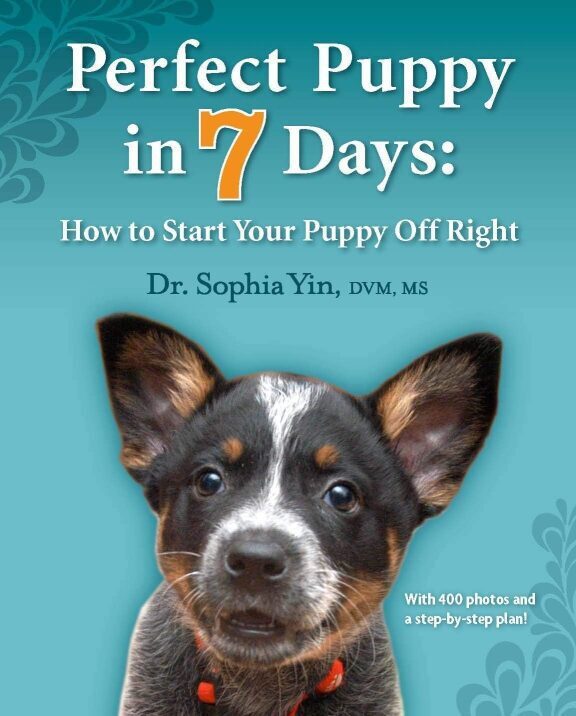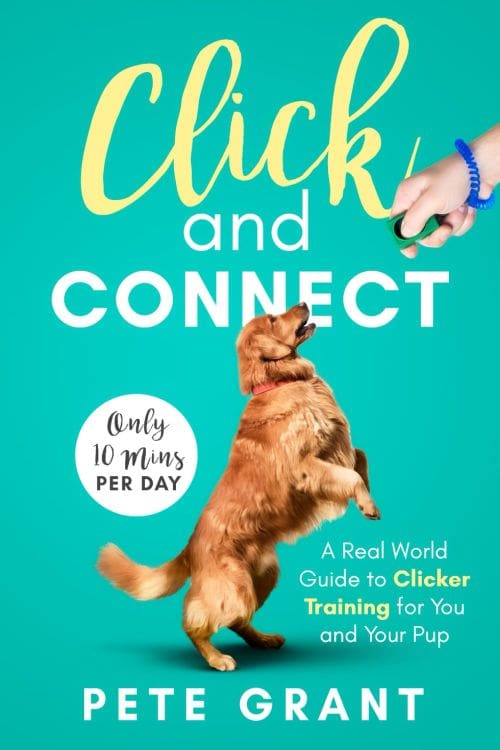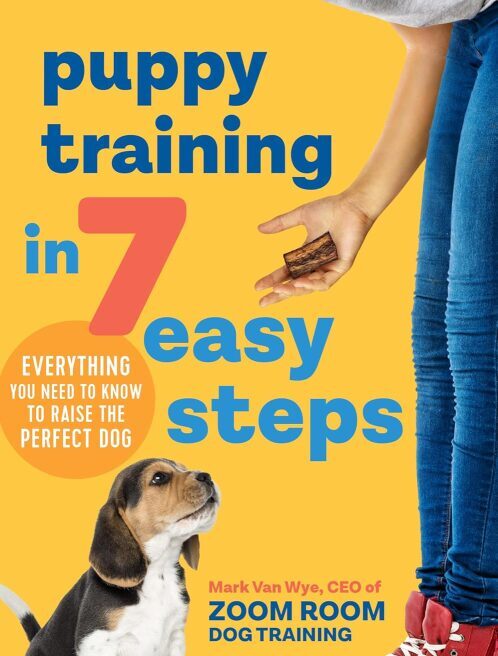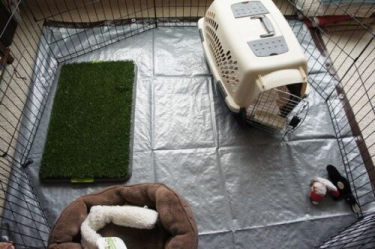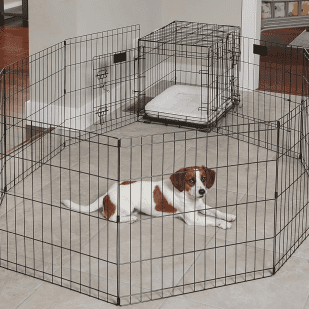Click and Connect: A Real-World Guide to Clicker Training for You and Your Pup
by Pete Grant
Unlock your dog’s potential with Click and Connect, the ultimate guide to positive reinforcement. This easy-to-follow book offers step-by-step instructions, real-life examples, and practical tips to help you train your puppy effectively.
“Click and Connect” covers a wide range of training techniques and is divided into easy-to-follow sections packed with practical tips, step-by-step instructions, and real-life examples.
Puppy Training in 7 Easy Steps: Everything You Need to Know to Raise the Perfect Dog
by Zoom Room Dog Training
Teach your pup the ropes with Puppy Training in 7 Easy Steps. This step-by-step guide shows you how to combine positive reinforcement with your dog’s natural instincts during training. They’ll learn essential manners and boundaries―while both of you bond and have lots of fun!
Youtube Videos
First Week Puppy Training Video
By McCann Dogs
Puppy training can start the first week that your puppy comes home. In this video, Instructor Lauren will show you 5 things to work on for your first-week puppy training plan.
New Puppy Series
By McCann Dogs
This video series is a complete guide for bringing a puppy home and includes how to prepare your home , puppy crate training, to puppy potty training.
Being prepared for your new puppy will give you the confidence you need to succeed!
In this series, we follow the journey of training Euchre in the early stages of puppy training
Crate Training Tips!

Do your Puppy a Favor and Crate Train Your Puppy!
Crate training is a great way to give your puppy a safe, cozy space to relax, and when done correctly, it’s a key tool for house training and reducing anxiety.
The whole point of using a crate for potty training is that a
dogs natural instinct is to keep themselves clean and not to go to the bathroom where they sleep.
How to Crate Train Your Puppy
Create Positive Associations
Make the crate a welcoming place by lining it with a soft blanket, adding a few toys, and keeping the door open so your puppy can explore at their own pace. As they become more comfortable, encourage them to go
inside by tossing treats or feeding meals in the crate. This will help them associate the crate with positive experiences.
Introduce Gradually
Start by closing the crate door for short periods while you’re nearby. Slowly increase the time, making sure your puppy stays calm. Never use the crate as punishment! It should be a safe, comforting space where
your puppy feels secure, not scared.
Incorporate into Daily Routines
Crate your puppy when you’re busy, like preparing meals or working, to help them get used to it. However, puppies, especially younger ones, shouldn’t be crated for long periods. Make sure to give them plenty of
playtime and bathroom breaks outside the crate to avoid boredom or anxiety.
Timing is Key
Puppies should never stay crated for too long. A general rule of thumb is that a puppy can hold its bladder for an amount of hours equal to its age in months plus one. So, for example, a 3-month-old puppy can stay
crated for about 4 hours.
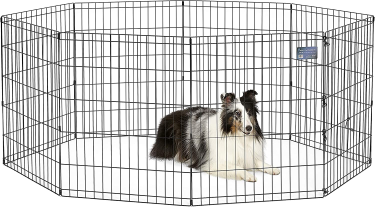
What is an x-Pen?
An exercise pen, or playpen, is a portable enclosure that provides puppies with a safe, contained space especially useful for families who still need to work and won’t be able to let their puppy out of a crate frequently enough during the day (every 2-3 hours during the day and every 6-7 hours at night).
Exercise Pen and Crate
During the potty training stage, you can use both a crate and an x-pen together or separately.
The crate works best for sleeping and quiet moments at night, while the x-pen is perfect for daytime use, playtime, or providing a safe space when you can’t supervise your puppy, like when you’re at work or away from the house.
You can add a potty spot with a grass patch or a washable pad to the x-pen setup and put a tarp under your pen to avoid messing up your floors.
Puppy Enclosure Setup
To set up a puppy pen, choose a quiet, easily cleanable area in your home, place a secure exercise pen with crate attached or in the pen and equip it with all the essential items like a fresh water, food bowls, and a few safe chew toys, ensuring the pen is secured against a wall or anchored to prevent escape; regularly monitor your puppy while in the pen.
- The Midwest Crates easily connects to the Midwest X-Pens (see example) or you can just put the crate in the pen.
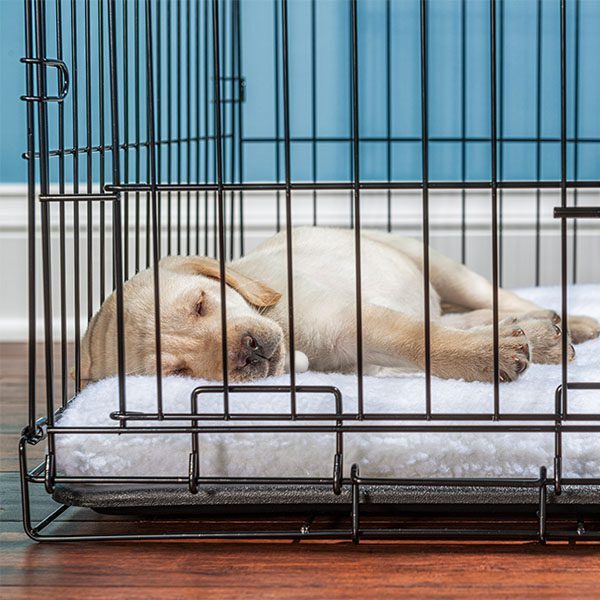
Buying a Crate
- I recommend the Midwest iCrates or the Midwest Life Stages Crates.
- A larger crate can work from puppyhood to adulthood by using the included wire divider to adjust the space during the crate training process.
- Ensuring your puppy has the right amount of room—no more, no less! Just enough space to lay down stand up and turn around.
Recommended size for our Mini/Moyen sized puppies:
Midwest iCrates Size: Med: 30-in L x 19-in W x 21-in H
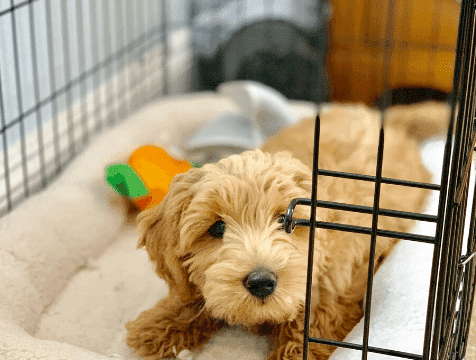
Covering the Crate: Drape a blanket over the top and sides to reduce external stimulation.
Toys & Chews: Add safe toys or chew items to keep your puppy occupied.
Setting Up the Crate
Crate Location: Place the crate in a calm, quiet area, preferably near you.
Positive Introduction: Start by placing your puppy in the crate during the day with the door open. Sit nearby, pet, and soothe them to help them associate the crate with calm, positive experiences.
What About Beds? Avoid using a bed initially since puppies often will pee on absorbent materials. Once your puppy is going potty outside consistently, then you can introduce a comfortable bed.
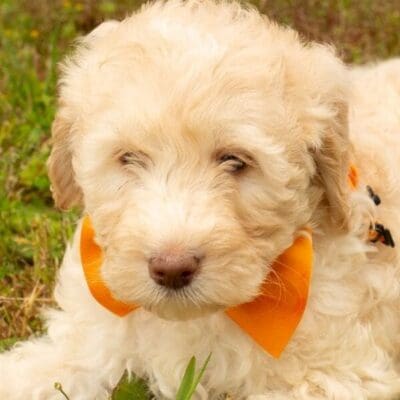
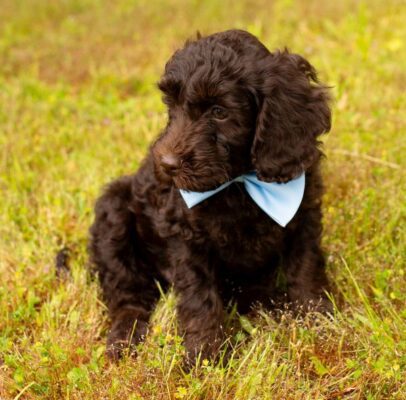
Crate Introduction in 3 Easy/Slower Steps
Step 1: Start with Crate Familiarization
- Put the crate on your bed or the floor and put your puppy in the crate.
- Lay next to the crate (with the door open), position your body to gently block the entrance, and put your arm inside the crate with your puppy.
- Speak to your puppy in a calm, soothing tone and softly pet them and try to get them to relax with you.
- You can give them a chew stick to help distract them but it’s important to remember that this is not playtime, the goal is to calm them down, not to get them excited.
- The goal is to create a relaxed, positive environment around their crate.
Step 2: Close the Door Gradually
- Once your puppy is comfortable, gently close the crate door while staying nearby.
- Continue offering reassurance through your presence and voice to help them associate the crate with security and calmness.
Step 3: Increase Distance and Close the Room Door
- When your puppy seems relaxed or better yet, asleep, with the door open, you can begin moving a short distance away from the crate.
- Eventually, close the room door to help them adjust to being alone in the crate.
- Be patient, as this transition may take a few attempts. A bit of whining is normal, but avoid reinforcing frantic behavior.
This is a gradual process that will help your puppy feel more safe and comfortable in their crate, fostering independence over time.
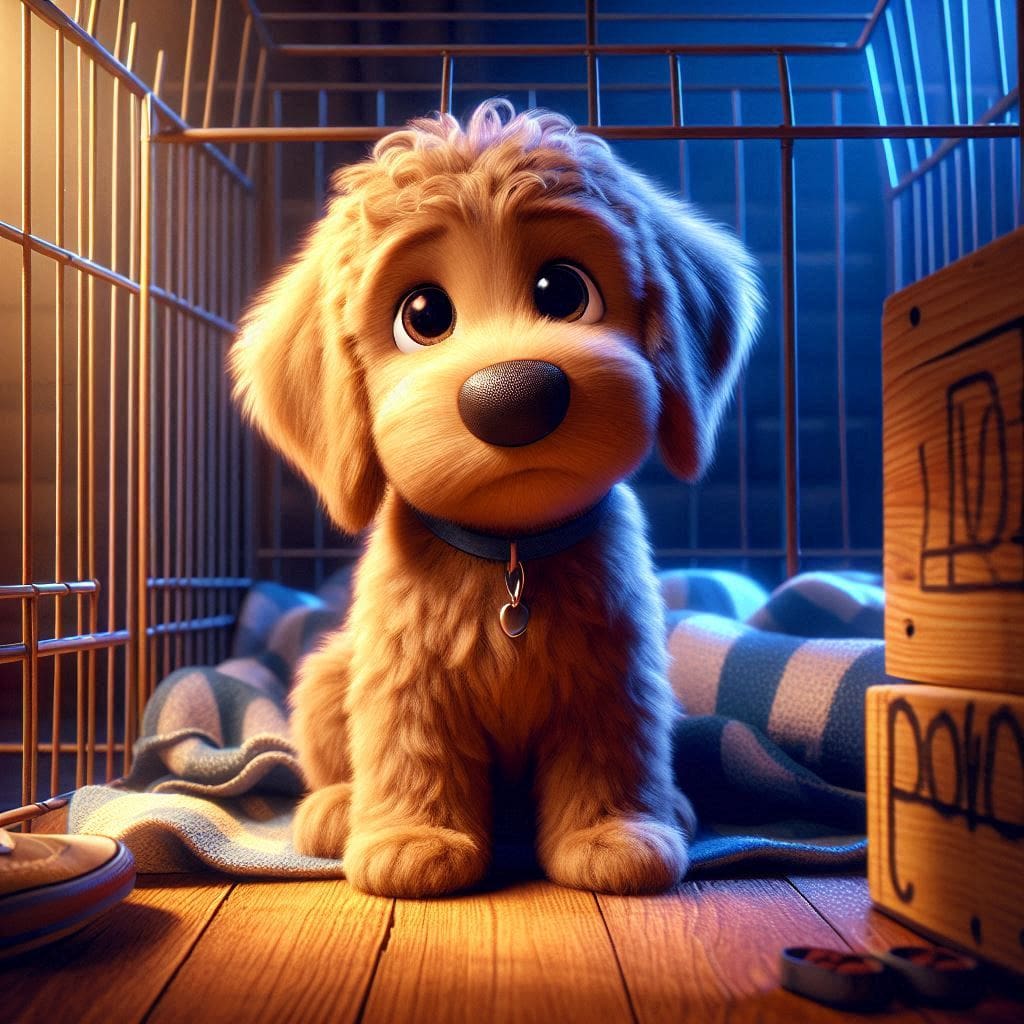
Wait for a moment of quiet before opening the crate door, this is a very good time to take them outside for a quick potty break and try again when they’ve calmed down.
What to do with a Frantic Puppy in the Crate?
There’s a huge difference between a “frantic puppy” and “normal crying and complaining puppy”. Never let your puppy get totally frantic in their crate.
Frantic puppy behavior can actually sound more like screaming, while they desperately try to escape, or potentially hurt themselves by trying to bite and scratch at the crate.
Frantic behavior happens for a few reasons:
- First-time crate experience: If you just stuck them in the crate and shut the door without easing them into it, you may have moved too fast. Slow down and start over.
- Too much freedom too soon: If you’ve allowed your puppy full access to the house, let them sleep in your bed, and then suddenly tried putting them in a cage, it’s no surprise they’re gonna be upset. This “spoiled puppy” behavior can feel like a tantrum, as they’re already used to having full freedom.
- Your puppy is overstimulated which can happen when your dog is overwhelmed and can’t cope with certain triggers in their environment. Slow down.
Some puppies may struggle with crate training more then others and it might take a little longer, but in my experience, I’ve never had a puppy who didn’t eventually come to enjoy having a safe space to relax and sleep in their crate.
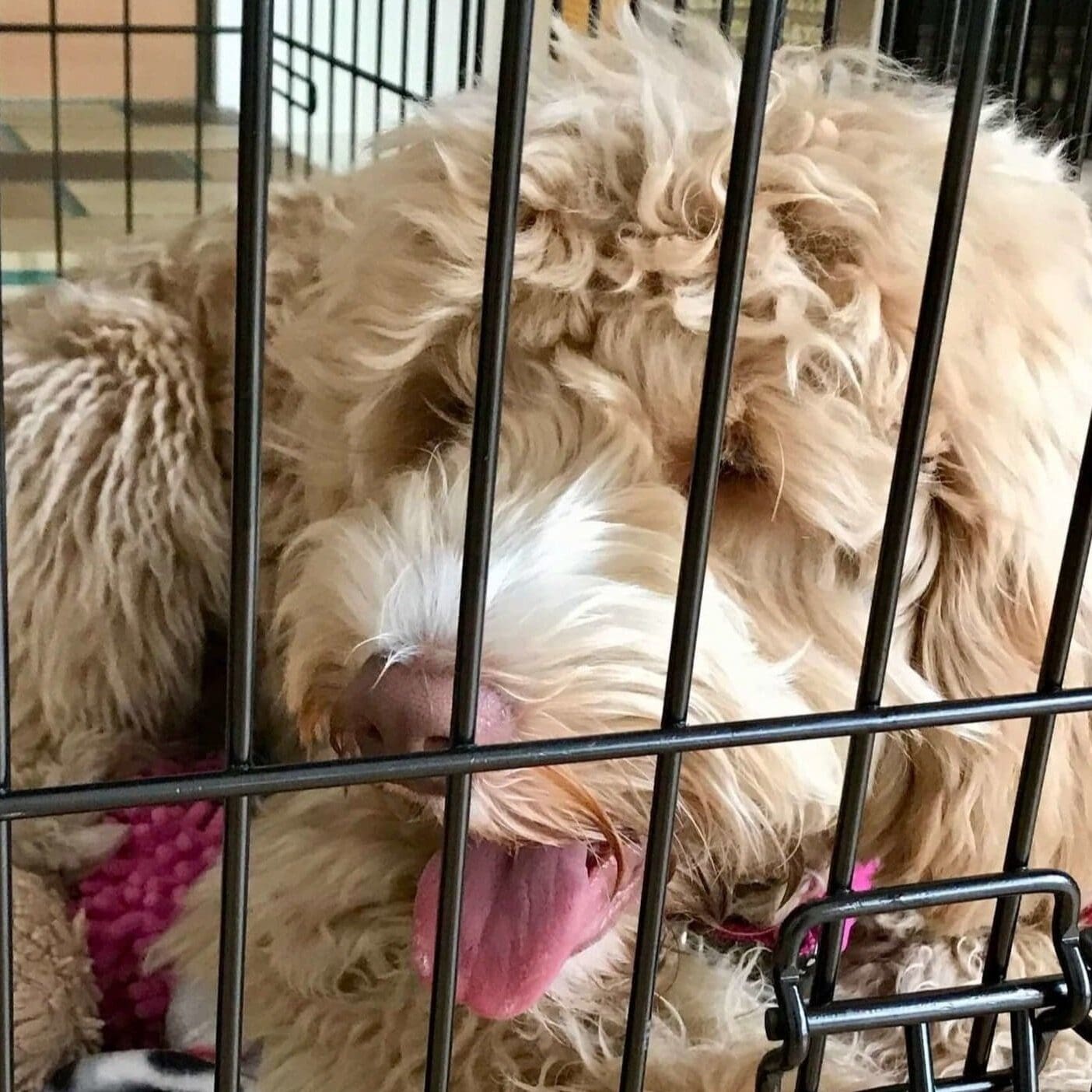
the answer is always the same:
start over and re-introduce the crate slower.
Take your time. The introduction process can take a day or so with some puppies, so remember to be patient.
It’s best to do this training during the day when you don’t need sleep.
Tone of Voice and Body Language Matters:
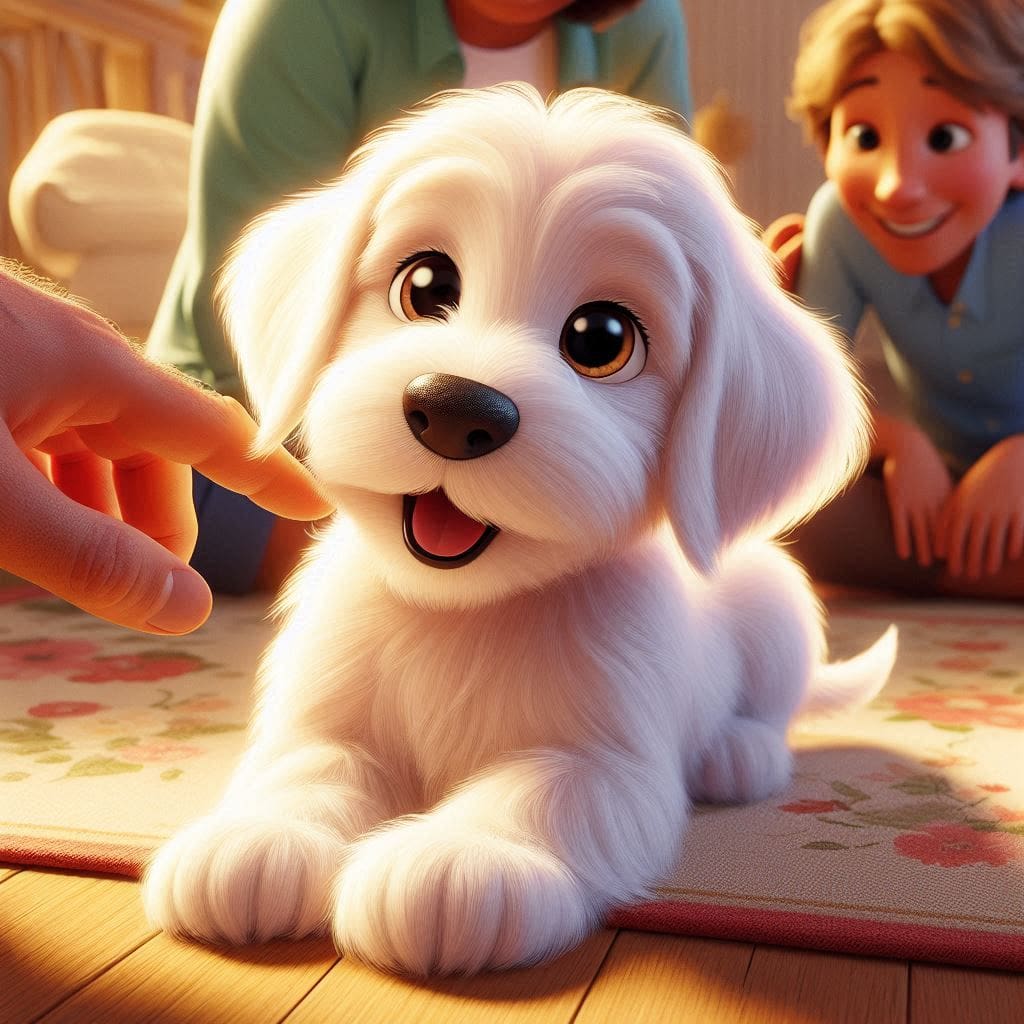
Tone of Voice:
Be mindful of your tone of voice and your body language when training your puppy. Dogs recognize and respond to our voice patterns. They’ll associate your vocal cues, tone of voice, and speech patterns with your different emotions and use this information to better understand how to work with us and interact with us.
- Cheerful tones show approval and playfulness, while disappointed tones convey disapproval.
- Soft and reassuring tones express affection
- Firm tones get a dog’s attention.
- The Caution tone should be used for emergencies to stop your dog in its tracks.
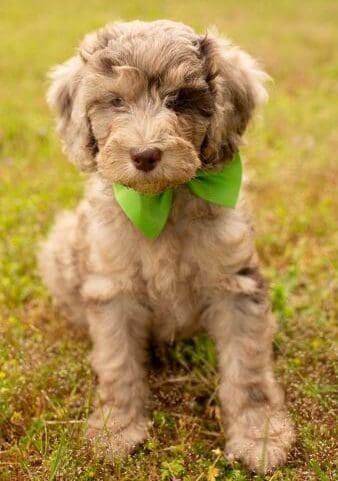
If you’re acting anxious or frantic, Then your puppy will pick up on this and become more anxious themselves.
Puppies often look to us to gauge their environment. If you’re acting unusually nervous or worried, then they’ll assume there must be something to be anxious or nervous about, and mirror your energy.
Take a deep breath. It’s most likely not as serious as it seems. Remember, your puppy is not hurt in the crate—they’re more than likely being loud and dramatic because it worked with you in the past.
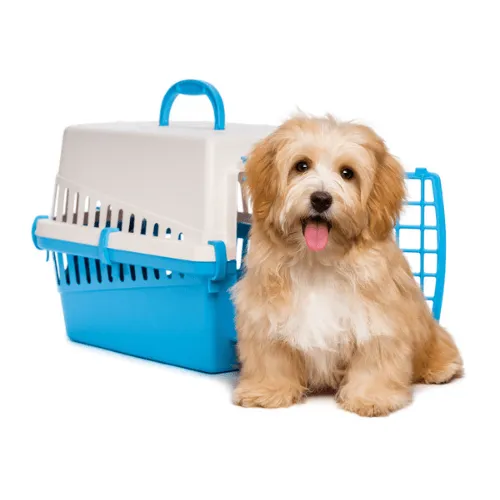
Potty Training Tips
- Establish a routine for your puppy, as they need frequent bathroom breaks, especially after eating, drinking, playing, and napping.
- A consistent feeding/eating and sleeping schedule is also VERY important.
- Do not “free feed” your puppy! What’s scheduled to go in, will come out on scheduled as well.
- Put them on a timed feeding schedule so that you can better gauge when they need to go outside. Usually about 30 min after they eat. Most puppies need to eat puppy food 2-3 times a day. Make it easier to remember by planning their meal times around your own breakfast, lunch, and dinner.
- Take your puppy outside on a leash to the same spot each time.
- Use the same que word every time like “Go Potty” and when they go potty in the right place, praise them and offer them a treat.
- Keep an eye on your puppy while they’re indoors, watching for body language cues they need to “go” like sniffing or circling and when you do, quickly pick them up and take them outside to their potty spot.
- Handle accidents calmly. If accidents happen and they will, clean them up promptly with an enzymatic cleaner to remove any odors and prevent your puppy from eliminating in the same spot again.
- Avoid harsh punishment, as your puppy will not associate the punishment with their earlier behavior and may begin to fear you. Instead, stay calm and focus on cleaning up the spot thoroughly to avoid them smelling their urine and peeing in that spot again.
- Never compare your new puppy to your last puppy or your friends puppy. Every puppy just like every human child is their own unique individual and will react differently to new experiences like potty training.
Adopt a puppy! it will change your life!
One of the most obvious benefits of having a dog is the sheer joy they bring.

